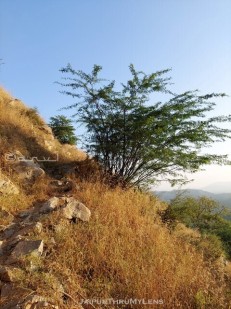My earliest memories of Khejri trees are from the car journeys I made in my childhood to Shekhawati in Rajasthan. Khejri trees were ubiquitous after a 70km drive from Jaipur. The semi-arid landscape on either side of a single-lane road was dominated by Khejri trees. Often the trees were pruned.
Akada Bushes, Neem and Khejri trees was all you could see for miles. A few years later, as a stamp collector, I got a stamp from India Post with the Khejri tree on it.
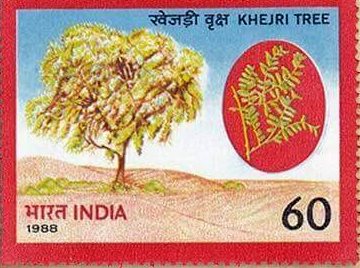
Names of Khejri Tree
The scientific name of the Khejri tree is Prosopis Cineraria. In India, it is also known by many other names such as Shami, Khijro, Jhand, Jat, Khar, Kanda and Jammi depending on the region. In Rajasthan it is called as Khejri or Khejro. It is called Ghaf in the Middle East.
Where can one find the Khejri tree?
Khejri is the most dominant tree of western Rajasthan; and for this exact reason Khejri is called the state tree of Rajasthan. It was declared a state tree in 1982-83. The tree is also present in the Middle East and is called Ghaf Tree. One can also find Khejri Tree in some parts of Haryana bordering Rajasthan with similar ecological conditions.
Due to rapid urbanization, the tree is not easy to spot in cities like Jaipur. The Forest Dept. has preferred decorative and flowering trees such as Gulmohar and Golden Shower Cassia tree over native species. One can definitely find the Khejri tree in the suburbs and villages near Jaipur.
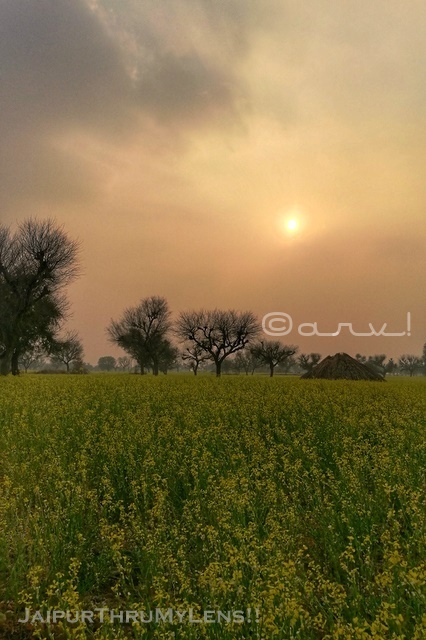
Connection of Khejri Tree with Jaipur & Lord Ram
The tree is closely associated with the history of Jaipur. During the days of kingship, the king worshiped the Khejri tree on the day of Dussehra at Dussehra Kothi in Jaipur. The rulers of Jaipur were Kacchawa Rajputs, the descendants of Lord Ram. It is believed that Lord Ram worshiped a Khejri tree before the last battle with the king of Lanka, Ravana. In this battle, Lord Ram killed Ravana. Dussehra is one of the festivals that precede Diwali and is a celebration of this victory by Lord Ram. This tradition of worshiping the Khejri tree in the royal family of Jaipur nevertheless continues in a modified and scaled-down manner.
The leaves resemble Gulmohar leaves and are similar to those of other trees of the same family such as Babool, Sickle Bush tree, Prosopis Juliflora or Vilayti Babool. All these belong to the Fabaceae family. Here are a few photos of leaves from this family.
Fruits & Leaves
The peaks in Khejri are very small and appear as a single unit. It drops its leaves in January and new ones appear in February-March. The fruit appears between May-July in the form of a slender stalked pod of 7-20 cm. Initially it is green in color and later changes to the brownish shade.
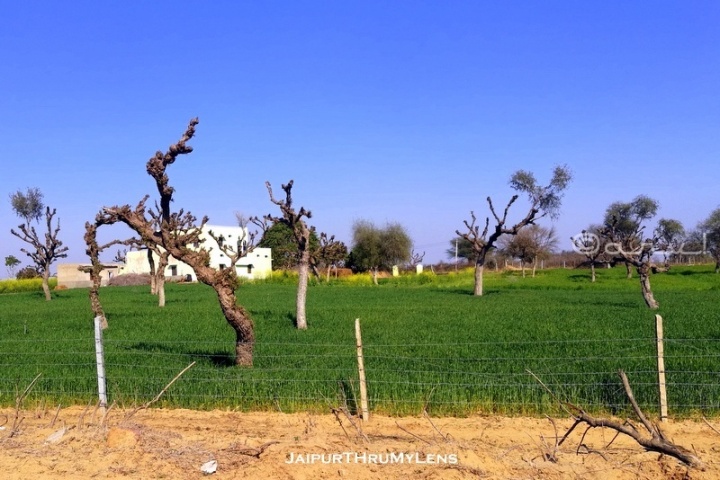
Use of Khejric
It makes sense to ask what is the use of the Khejri tree? The Khejri tree used to play a vital role in the economy of villages and rural areas.
- The leaves are used as animal feed and therefore the tree is seen in a pruned state. A single tree provides about 60 kg of feed for livestock annually. The pruning is also done to improve tree growth at the beginning of the winter season.
- Apart from this, leaves also make excellent compost.
- The wood of the tree is used for preparing food as firewood.
- Some documents suggest that the bark of Khejri was used as flour during the Famine of Rajputana in 1869. Even today, the bark is used in the treatment of many skin conditions such as leprosy, boils and itching. It is used in the treatment of asthma in Ayurveda.
- The flowers of this tree are consumed by pregnant women along with sugar.
- The farmers are happy that this tree is in the field, because the root enriches the soil and thus increases the crop yield.
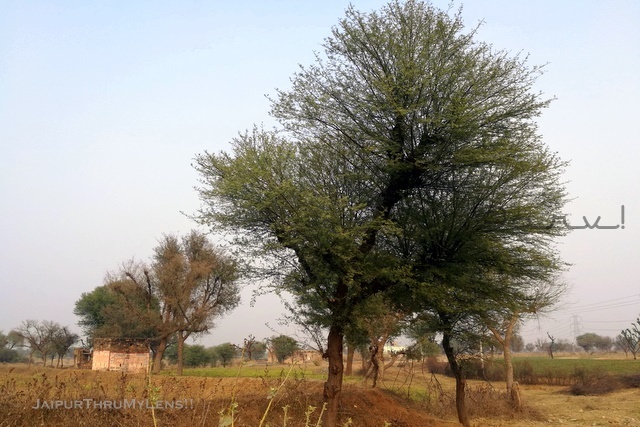
Sangria
The texture of the bark of the Kheri tree is very similar to that of the Neem tree – rough and cracked. The dried fruit of the tree is used as Sangri. People who appreciate Rajasthani food must have heard of Ker Sangri. While Ker grows on a shrub, Sangri is derived from the Khejri tree. The fruit in summer. Sangri is a hanging bean-like pod. These pods are used as feed.
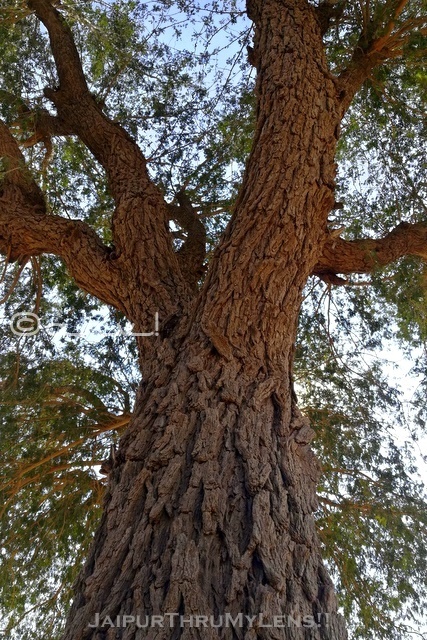
Benefits
The tree is a hardy tree that requires less care, which explains why it is easily seen in the Thar Desert. It can survive in cold and very hot conditions with a temperature range of 5-47 C. The tree is known for its ability to bind the soil. Its roots can reach a considerable depth in search of the water sources. The Khejri tree is found in areas with an annual rainfall of less than 75-80 cm. This is one of the secrets to its survival in the hot and harsh climate. According to a report by the Central Arid Zone Research Institute in 2015, the Khejri tree is gradually losing its ground. The area covered by this tree has decreased significantly. This tree is said to have been found in Punjab in the past. But with the increased availability of water, the scenario has changed. It is unlikely to be found where annual rainfall exceeds 100cm. A number of reasons are given against this phenomenon, but these are just theories. We still don’t know the exact cause. It would not be incorrect to say that changes in rural lifestyles from agrarian to modern are one of the main causes. New water sources and the availability of modern fertilizers have brought changes that will affect the old way of working. Even then, an important landscape in Rajasthan is covered by the Khejri tree. The tree takes a long time to grow and unless we plant many more trees now, the situation is unlikely to change. Central Arid Zone Research Institute (CAZRI) in Jodhpur is involved in Khejri tree research.

View other stories in the trees of Jaipur.
Stay informed via Facebook, Twitter, Instagram
Threats and reasons for declining population of Khejri boom
It is a pity that the Ministry of Forestry has not been a catalyst in promoting this tree. We have seen ill effects from the poor policies that the Forest Dept. in recent years by promoting imported trees such as Israeli Babool and Australian Eucalyptus. Both trees have been counterproductive and have caused more damage than profit. In the latter case, the soil underneath would become barren. Local trees support the local ecology, but imported trees do not. The Khejri tree is connected to many historical events, such as the Chipko movement founded by Sunderlal Bahuguna in the 1970s. It is claimed that this movement was itself fueled by an event that took place in Jodhpur in the early 18th century. A king ordered the cutting of Khejri trees; the local Bishnoi community opposed the move to save them from being harvested.
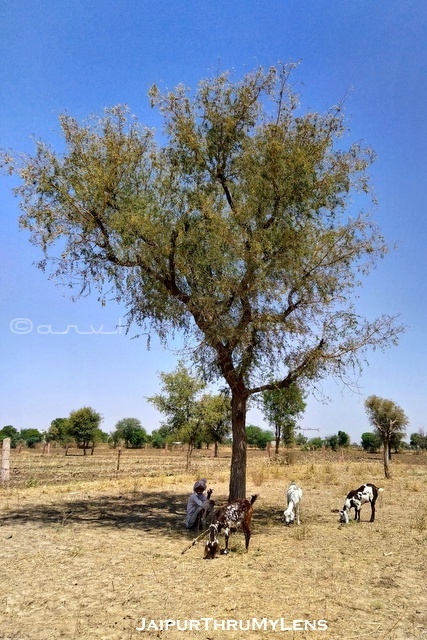
During the Chipko movement or Chipko Aandolan, people in Uttarakhand started hugging trees to prevent loggers from cutting down trees. Unfortunately, despite considering Khejri as the state tree of Rajasthan, the government has nothing. The government has not criminalized the felling of this tree, nor has it planned for the planting of Khejri trees. During the famine of 1899, many people survived by eating the bark of this tree.
We need native trees such as Neem, Peepal and Dhok to name a few to preserve the local ecology. What is your vision? Have you ever seen a Kheri tree? Or ever tried Ker Sangri in Jaipur or elsewhere in Rajasthan?
Read full posts about trees found in Jaipur – Trees of Jaipur



